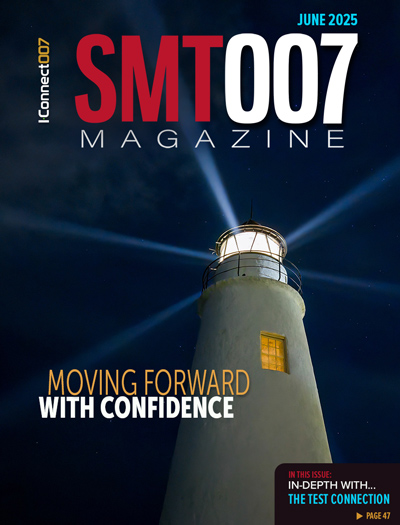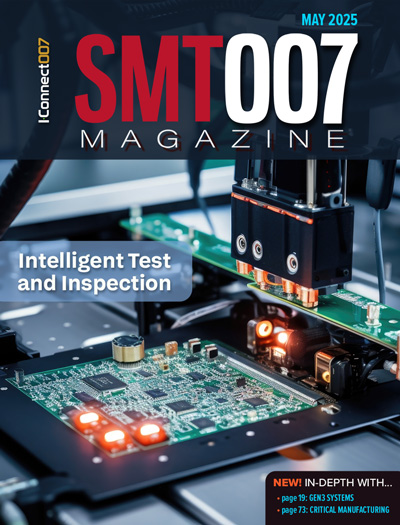-

-
News
News Highlights
- Books
Featured Books
- smt007 Magazine
Latest Issues
Current Issue
What's Your Sweet Spot?
Are you in a niche that’s growing or shrinking? Is it time to reassess and refocus? We spotlight companies thriving by redefining or reinforcing their niche. What are their insights?

Moving Forward With Confidence
In this issue, we focus on sales and quoting, workforce training, new IPC leadership in the U.S. and Canada, the effects of tariffs, CFX standards, and much more—all designed to provide perspective as you move through the cloud bank of today's shifting economic market.

Intelligent Test and Inspection
Are you ready to explore the cutting-edge advancements shaping the electronics manufacturing industry? The May 2025 issue of SMT007 Magazine is packed with insights, innovations, and expert perspectives that you won’t want to miss.
- Articles
- Columns
- Links
- Media kit
||| MENU - smt007 Magazine
Murata’s Revolutionary Stretchable Printed Circuit Elevates Wearable Medical Devices Printed Circuit Products
October 31, 2024 | MurataEstimated reading time: 2 minutes
Murata Manufacturing Co., Ltd reveals an innovative new Stretchable Printed Circuit (SPC) technology marking a significant development in printed circuit technology. Murata's SPC represents the next advancement in substrate development, providing both flexibility and the capability to stretch and deform while maintaining full functionality. It is perfect for creating advanced medical products, like wearable therapeutic devices and vital monitoring tools, that can provide better accuracy, durability, and patient comfort than today’s equivalent devices.
In recent years, in the medical field, to make more accurate diagnoses, the importance of sophisticated tests performed in hospitals and biometric information collected continuously in daily life has increased. Daily vital sign monitoring is important to prevent lifestyle-related diseases, therefore wearable medical devices are now ubiquitous. However, existing devices are often too stiff for many applications, creating issues like patient discomfort, poor surface contact, or unstable data acquisition. Murata's SPC excels in its inherent flexibility, stretchability, and ability to adapt, supporting multi-sensing functionalities to address diverse user requirements. The material is incredibly soft and gentle on the skin, making it ideal for medical and wellness devices like EEG (Electroencephalogram), EMG (Electromyogram), and ECG(Electrocardiogram). Its stretchable nature can enable a single device to accommodate various body areas and patients of different sizes, as well as allowing more easily for continuous monitoring applications or monitoring in previously challenging areas such as elbows or knee joints.
Engineered with cutting-edge capabilities, including printing stretchable electrodes compliant with ANSI/AAMI EC12 standards, SPC paves the way for next-generation medical devices. It achieves seamless integration and optimal performance through innovative telescopic component mounting and hybrid bonding technology between substrates. By effectively blocking electromagnetic noise, the unique shield layer offers reliable protection for the signal path. Additionally, the substrate construction demonstrates excellent reliability, with high resistance to moisture and the ability to withstand high voltages for long durations, while allowing for more flexibility in component mounting, giving designers more freedom to innovate.
Murata's SPC can be tailored to meet individual customer specifications with the help of Murata’s extensive range of resources to facilitate collaborative product development. This can be harnessed by product designers, enabling them to optimize their designs. Murata can further support development by conducting tests in various conditions and resolving failure modes by identifying their root causes. Depending on the required specifications, filters, amplifiers, and multiple sensors can be mounted on a single sheet, enabling accurate data acquisition and sensing of several items. With this solution, Murata performs custom design, prototyping and verification, and mass production based on the required specifications.
Suggested Items
Knocking Down the Bone Pile: Addressing End-of-life Component Solderability Issues, Part 4
07/15/2025 | Nash Bell -- Column: Knocking Down the Bone PileIn 1983, the Department of Defense identified that over 40% of military electronic system failures in the field were electrical, with approximately 50% attributed to poor solder connections. Investigations revealed that plated finishes, typically nickel or tin, were porous and non-intermetallic.
Scanfil, MB Elettronica to Join Forces
07/14/2025 | ScanfilFinnish Scanfil, the largest European stock exchange listed Electronic Manufacturing Service company in terms of turnover, and Italian MB Elettronica (“MB”) from Cortona Arezzo have agreed to join forces.
OSI Systems Receives $34 Million Contract for Cargo and Vehicle Inspection Systems
07/11/2025 | BUSINESS WIREOSI Systems, Inc. announced that its Security division has been awarded a contract worth approximately $34 million by an international customer.
I-Connect007 Observes U.S. Independence Day Holiday
07/04/2025 | Nolan Johnson, I-Connect007Today marks the 248th anniversary of the signing of the American Declaration of Independence by the Continental Congress. Known widely in the U.S. as Independence Day or “The Fourth of July,” this day also commemorates the declaration by the Congress that the American colonies are free and independent states.
The Knowledge Base: A Conference for Cleaning and Coating of Mission-critical Electronics
07/08/2025 | Mike Konrad -- Column: The Knowledge BaseIn electronics manufacturing, there’s a dangerous misconception that cleaning and coating are standalone options, that they operate in different lanes, and that one can compensate for the other. Let’s clear that up now. Cleaning and conformal coating are not separate decisions. They are two chapters in the same story—the story of reliability.


